Analysis of WiMAX Networks: Security, Encryption, and Challenges
VerifiedAdded on 2020/04/07
|14
|1447
|252
Report
AI Summary
This report provides a comprehensive overview of WiMAX networks, focusing on data encryption standards and security challenges. It begins by comparing and contrasting data encryption methods such as 3DES and AES used in WiMAX networks, highlighting their strengths and weaknesses. The report then delves into the security challenges faced by Wireless Ad-hoc Personal Area Network (WAPN) technologies, specifically Bluetooth and ZigBee, detailing threats like eavesdropping, bluesnarfing, bluebugging, and denial of service attacks. It also explores security vulnerabilities in ZigBee, including sniffing, replay attacks, and physical attacks. Additionally, the report includes a review of a research paper on energy harvesting in wireless sensor networks, discussing the growing importance of this technology. Finally, a case study on netbooks and mobile phones is presented to highlight their features and functionalities. The report concludes with a list of references for further reading.

Running head: WiMAX NETWORKS
WiMAX NETWORKS
Name of the Student
Name of the University
WiMAX NETWORKS
Name of the Student
Name of the University
Paraphrase This Document
Need a fresh take? Get an instant paraphrase of this document with our AI Paraphraser

1WiMAX NETWORKS
Table of Contents
1. Comparing and Contrasting Data Encryption standards for WiMAX.........................................2
2. Security challenges faced by WAPN technology........................................................................2
3. Paper Review: Energy Harvesting...............................................................................................4
References........................................................................................................................................5
Table of Contents
1. Comparing and Contrasting Data Encryption standards for WiMAX.........................................2
2. Security challenges faced by WAPN technology........................................................................2
3. Paper Review: Energy Harvesting...............................................................................................4
References........................................................................................................................................5
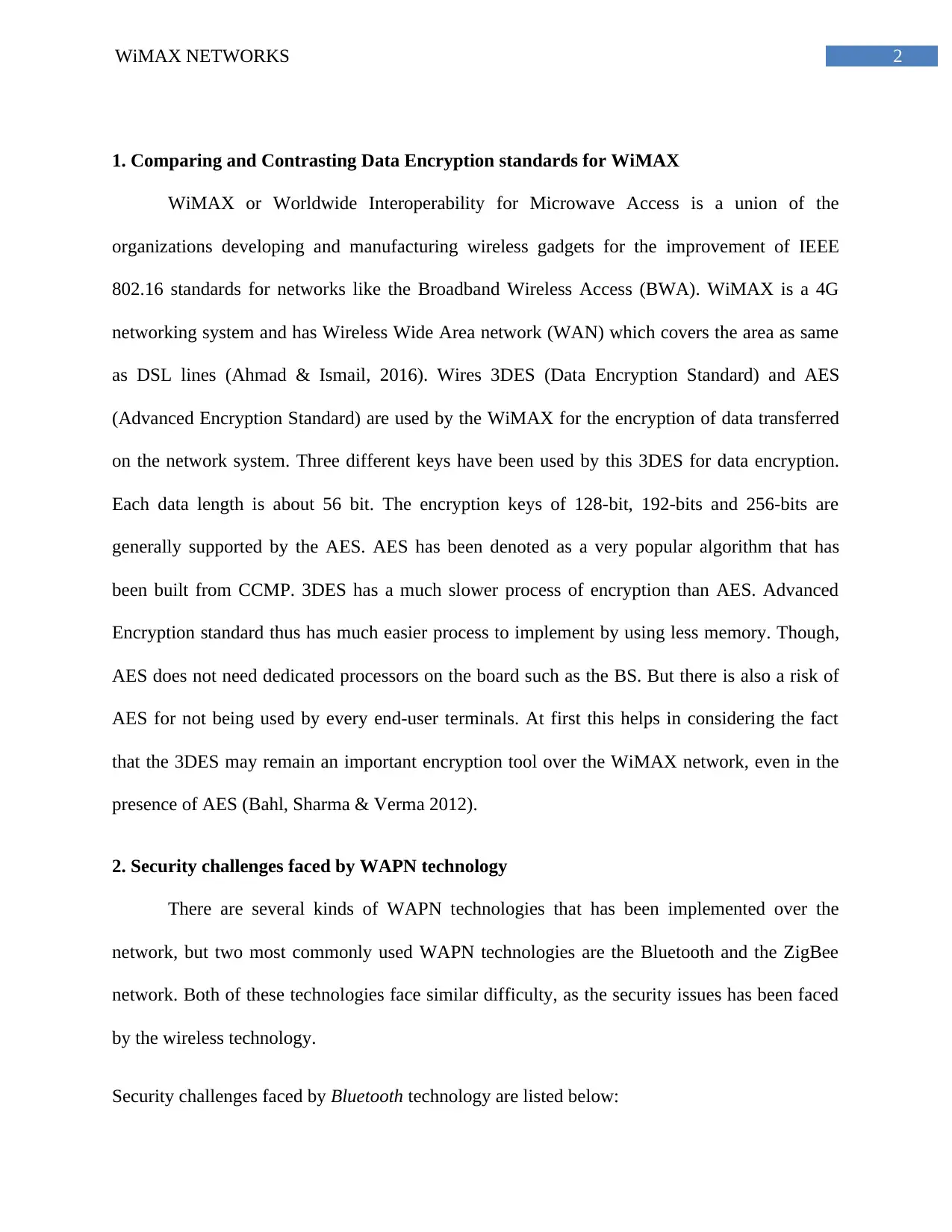
2WiMAX NETWORKS
1. Comparing and Contrasting Data Encryption standards for WiMAX
WiMAX or Worldwide Interoperability for Microwave Access is a union of the
organizations developing and manufacturing wireless gadgets for the improvement of IEEE
802.16 standards for networks like the Broadband Wireless Access (BWA). WiMAX is a 4G
networking system and has Wireless Wide Area network (WAN) which covers the area as same
as DSL lines (Ahmad & Ismail, 2016). Wires 3DES (Data Encryption Standard) and AES
(Advanced Encryption Standard) are used by the WiMAX for the encryption of data transferred
on the network system. Three different keys have been used by this 3DES for data encryption.
Each data length is about 56 bit. The encryption keys of 128-bit, 192-bits and 256-bits are
generally supported by the AES. AES has been denoted as a very popular algorithm that has
been built from CCMP. 3DES has a much slower process of encryption than AES. Advanced
Encryption standard thus has much easier process to implement by using less memory. Though,
AES does not need dedicated processors on the board such as the BS. But there is also a risk of
AES for not being used by every end-user terminals. At first this helps in considering the fact
that the 3DES may remain an important encryption tool over the WiMAX network, even in the
presence of AES (Bahl, Sharma & Verma 2012).
2. Security challenges faced by WAPN technology
There are several kinds of WAPN technologies that has been implemented over the
network, but two most commonly used WAPN technologies are the Bluetooth and the ZigBee
network. Both of these technologies face similar difficulty, as the security issues has been faced
by the wireless technology.
Security challenges faced by Bluetooth technology are listed below:
1. Comparing and Contrasting Data Encryption standards for WiMAX
WiMAX or Worldwide Interoperability for Microwave Access is a union of the
organizations developing and manufacturing wireless gadgets for the improvement of IEEE
802.16 standards for networks like the Broadband Wireless Access (BWA). WiMAX is a 4G
networking system and has Wireless Wide Area network (WAN) which covers the area as same
as DSL lines (Ahmad & Ismail, 2016). Wires 3DES (Data Encryption Standard) and AES
(Advanced Encryption Standard) are used by the WiMAX for the encryption of data transferred
on the network system. Three different keys have been used by this 3DES for data encryption.
Each data length is about 56 bit. The encryption keys of 128-bit, 192-bits and 256-bits are
generally supported by the AES. AES has been denoted as a very popular algorithm that has
been built from CCMP. 3DES has a much slower process of encryption than AES. Advanced
Encryption standard thus has much easier process to implement by using less memory. Though,
AES does not need dedicated processors on the board such as the BS. But there is also a risk of
AES for not being used by every end-user terminals. At first this helps in considering the fact
that the 3DES may remain an important encryption tool over the WiMAX network, even in the
presence of AES (Bahl, Sharma & Verma 2012).
2. Security challenges faced by WAPN technology
There are several kinds of WAPN technologies that has been implemented over the
network, but two most commonly used WAPN technologies are the Bluetooth and the ZigBee
network. Both of these technologies face similar difficulty, as the security issues has been faced
by the wireless technology.
Security challenges faced by Bluetooth technology are listed below:
⊘ This is a preview!⊘
Do you want full access?
Subscribe today to unlock all pages.

Trusted by 1+ million students worldwide
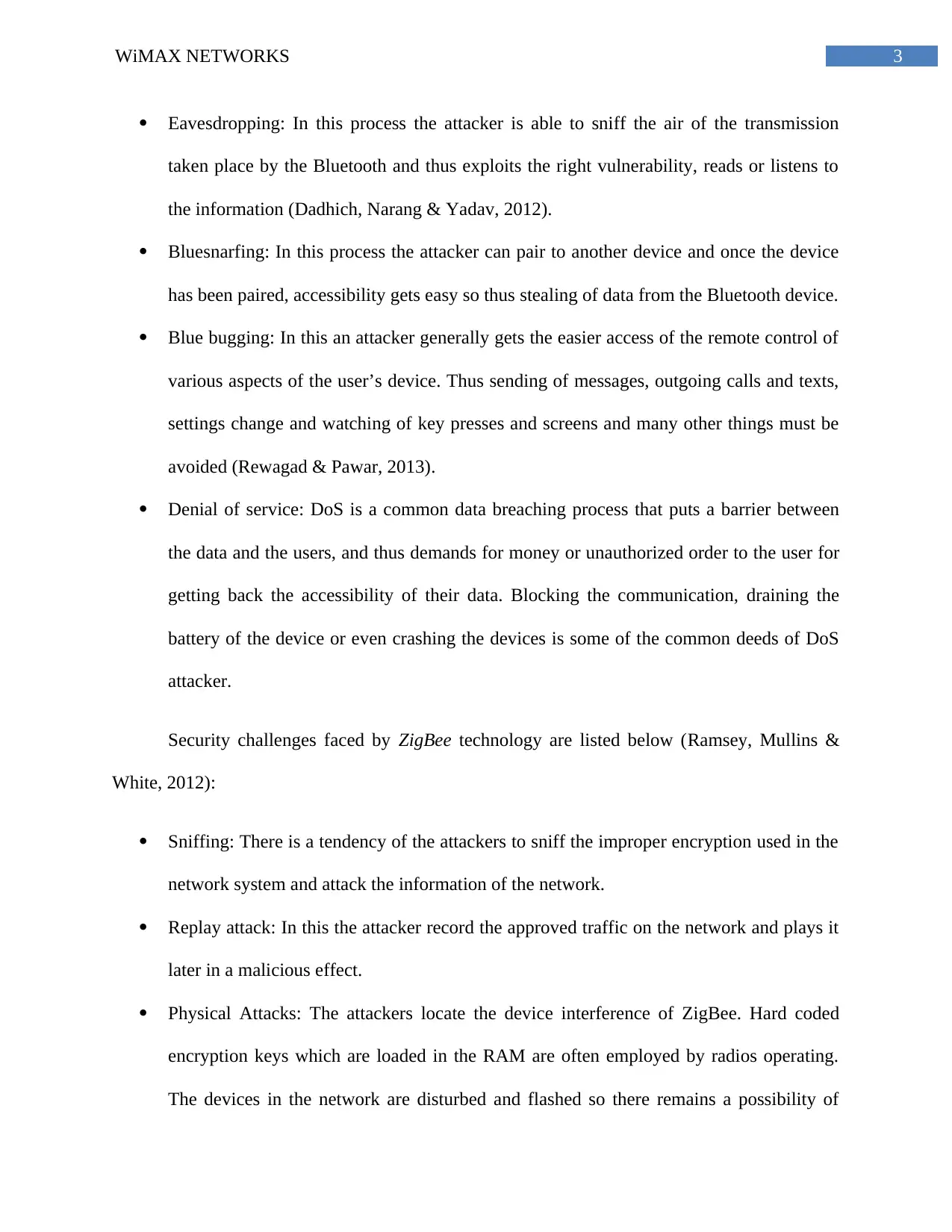
3WiMAX NETWORKS
Eavesdropping: In this process the attacker is able to sniff the air of the transmission
taken place by the Bluetooth and thus exploits the right vulnerability, reads or listens to
the information (Dadhich, Narang & Yadav, 2012).
Bluesnarfing: In this process the attacker can pair to another device and once the device
has been paired, accessibility gets easy so thus stealing of data from the Bluetooth device.
Blue bugging: In this an attacker generally gets the easier access of the remote control of
various aspects of the user’s device. Thus sending of messages, outgoing calls and texts,
settings change and watching of key presses and screens and many other things must be
avoided (Rewagad & Pawar, 2013).
Denial of service: DoS is a common data breaching process that puts a barrier between
the data and the users, and thus demands for money or unauthorized order to the user for
getting back the accessibility of their data. Blocking the communication, draining the
battery of the device or even crashing the devices is some of the common deeds of DoS
attacker.
Security challenges faced by ZigBee technology are listed below (Ramsey, Mullins &
White, 2012):
Sniffing: There is a tendency of the attackers to sniff the improper encryption used in the
network system and attack the information of the network.
Replay attack: In this the attacker record the approved traffic on the network and plays it
later in a malicious effect.
Physical Attacks: The attackers locate the device interference of ZigBee. Hard coded
encryption keys which are loaded in the RAM are often employed by radios operating.
The devices in the network are disturbed and flashed so there remains a possibility of
Eavesdropping: In this process the attacker is able to sniff the air of the transmission
taken place by the Bluetooth and thus exploits the right vulnerability, reads or listens to
the information (Dadhich, Narang & Yadav, 2012).
Bluesnarfing: In this process the attacker can pair to another device and once the device
has been paired, accessibility gets easy so thus stealing of data from the Bluetooth device.
Blue bugging: In this an attacker generally gets the easier access of the remote control of
various aspects of the user’s device. Thus sending of messages, outgoing calls and texts,
settings change and watching of key presses and screens and many other things must be
avoided (Rewagad & Pawar, 2013).
Denial of service: DoS is a common data breaching process that puts a barrier between
the data and the users, and thus demands for money or unauthorized order to the user for
getting back the accessibility of their data. Blocking the communication, draining the
battery of the device or even crashing the devices is some of the common deeds of DoS
attacker.
Security challenges faced by ZigBee technology are listed below (Ramsey, Mullins &
White, 2012):
Sniffing: There is a tendency of the attackers to sniff the improper encryption used in the
network system and attack the information of the network.
Replay attack: In this the attacker record the approved traffic on the network and plays it
later in a malicious effect.
Physical Attacks: The attackers locate the device interference of ZigBee. Hard coded
encryption keys which are loaded in the RAM are often employed by radios operating.
The devices in the network are disturbed and flashed so there remains a possibility of
Paraphrase This Document
Need a fresh take? Get an instant paraphrase of this document with our AI Paraphraser
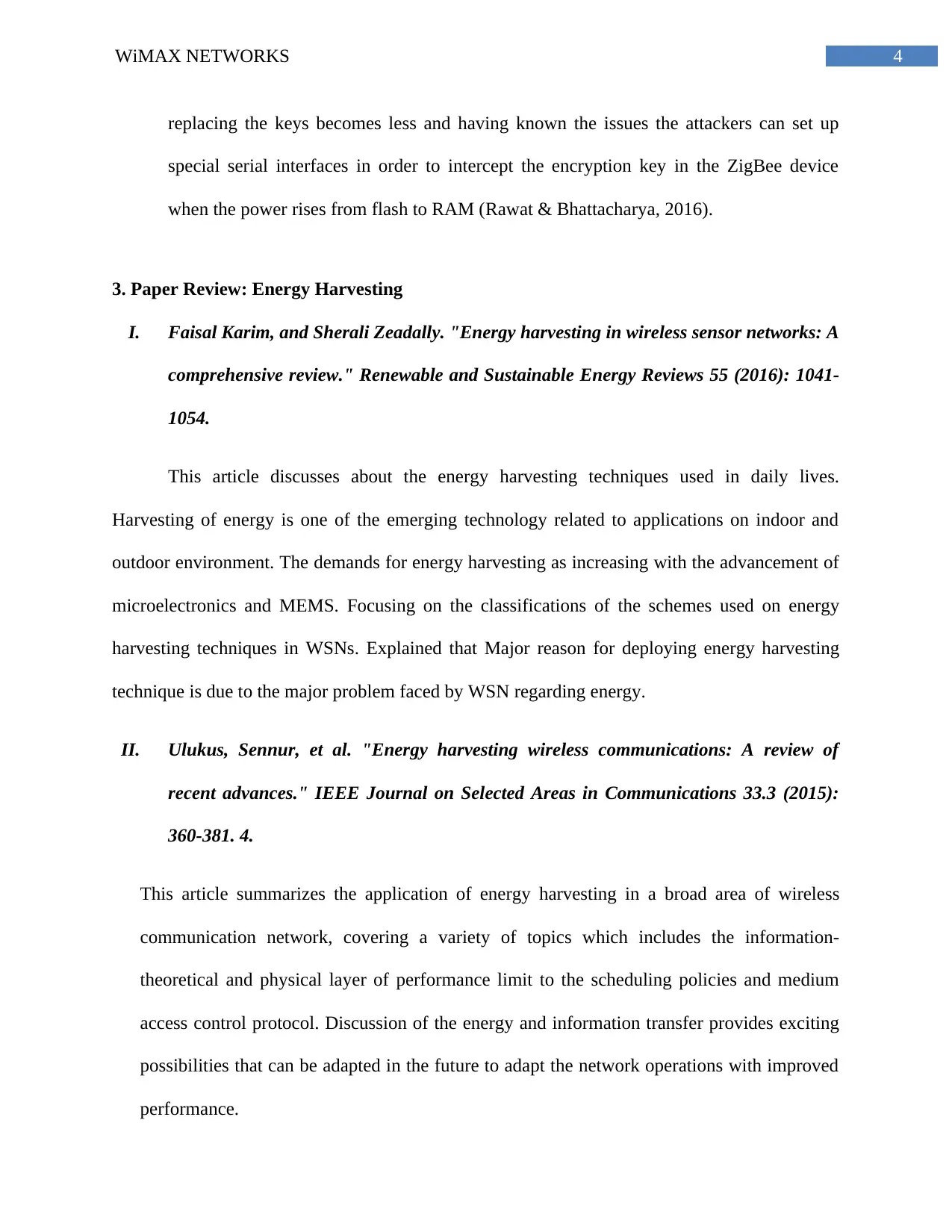
4WiMAX NETWORKS
replacing the keys becomes less and having known the issues the attackers can set up
special serial interfaces in order to intercept the encryption key in the ZigBee device
when the power rises from flash to RAM (Rawat & Bhattacharya, 2016).
3. Paper Review: Energy Harvesting
I. Faisal Karim, and Sherali Zeadally. "Energy harvesting in wireless sensor networks: A
comprehensive review." Renewable and Sustainable Energy Reviews 55 (2016): 1041-
1054.
This article discusses about the energy harvesting techniques used in daily lives.
Harvesting of energy is one of the emerging technology related to applications on indoor and
outdoor environment. The demands for energy harvesting as increasing with the advancement of
microelectronics and MEMS. Focusing on the classifications of the schemes used on energy
harvesting techniques in WSNs. Explained that Major reason for deploying energy harvesting
technique is due to the major problem faced by WSN regarding energy.
II. Ulukus, Sennur, et al. "Energy harvesting wireless communications: A review of
recent advances." IEEE Journal on Selected Areas in Communications 33.3 (2015):
360-381. 4.
This article summarizes the application of energy harvesting in a broad area of wireless
communication network, covering a variety of topics which includes the information-
theoretical and physical layer of performance limit to the scheduling policies and medium
access control protocol. Discussion of the energy and information transfer provides exciting
possibilities that can be adapted in the future to adapt the network operations with improved
performance.
replacing the keys becomes less and having known the issues the attackers can set up
special serial interfaces in order to intercept the encryption key in the ZigBee device
when the power rises from flash to RAM (Rawat & Bhattacharya, 2016).
3. Paper Review: Energy Harvesting
I. Faisal Karim, and Sherali Zeadally. "Energy harvesting in wireless sensor networks: A
comprehensive review." Renewable and Sustainable Energy Reviews 55 (2016): 1041-
1054.
This article discusses about the energy harvesting techniques used in daily lives.
Harvesting of energy is one of the emerging technology related to applications on indoor and
outdoor environment. The demands for energy harvesting as increasing with the advancement of
microelectronics and MEMS. Focusing on the classifications of the schemes used on energy
harvesting techniques in WSNs. Explained that Major reason for deploying energy harvesting
technique is due to the major problem faced by WSN regarding energy.
II. Ulukus, Sennur, et al. "Energy harvesting wireless communications: A review of
recent advances." IEEE Journal on Selected Areas in Communications 33.3 (2015):
360-381. 4.
This article summarizes the application of energy harvesting in a broad area of wireless
communication network, covering a variety of topics which includes the information-
theoretical and physical layer of performance limit to the scheduling policies and medium
access control protocol. Discussion of the energy and information transfer provides exciting
possibilities that can be adapted in the future to adapt the network operations with improved
performance.
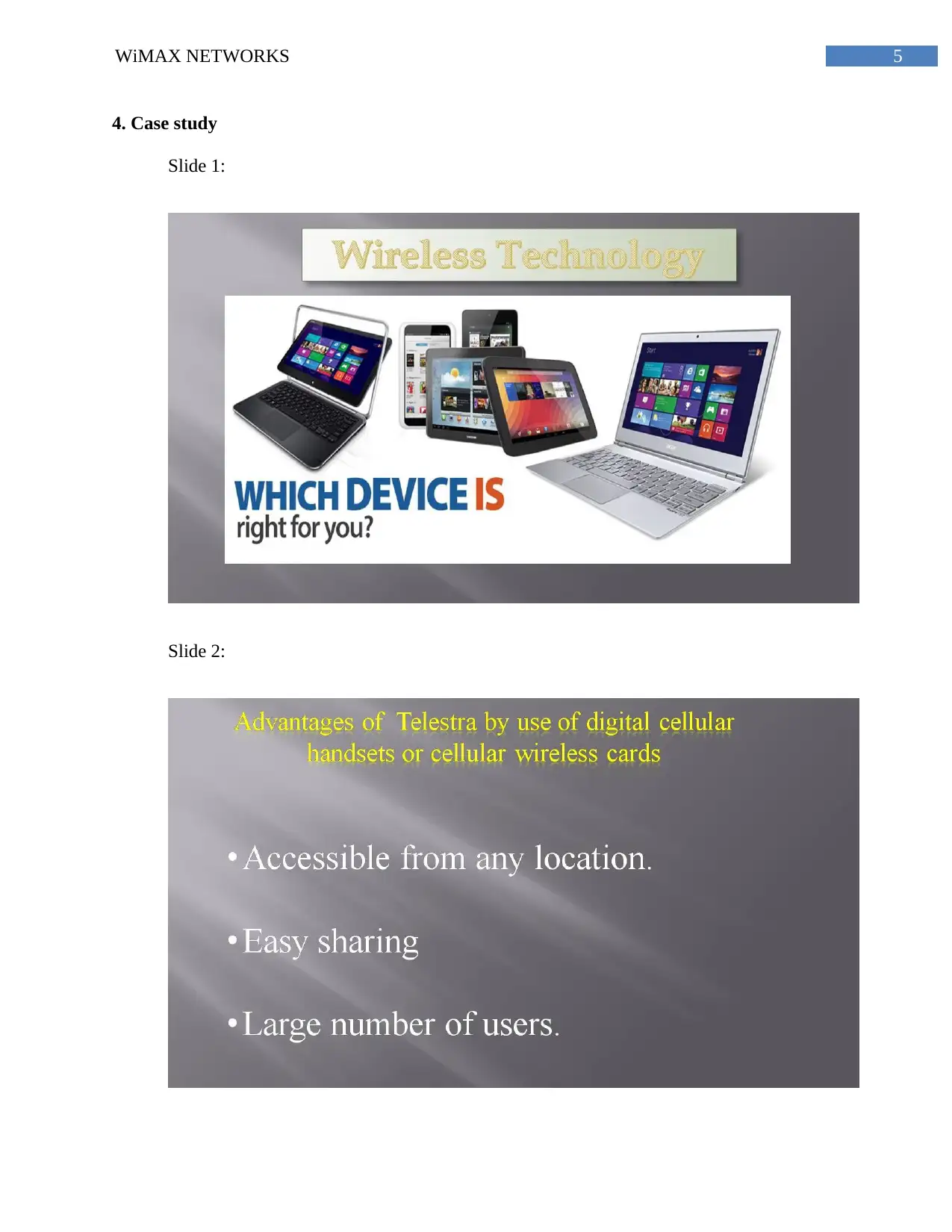
5WiMAX NETWORKS
4. Case study
Slide 1:
Slide 2:
4. Case study
Slide 1:
Slide 2:
⊘ This is a preview!⊘
Do you want full access?
Subscribe today to unlock all pages.

Trusted by 1+ million students worldwide
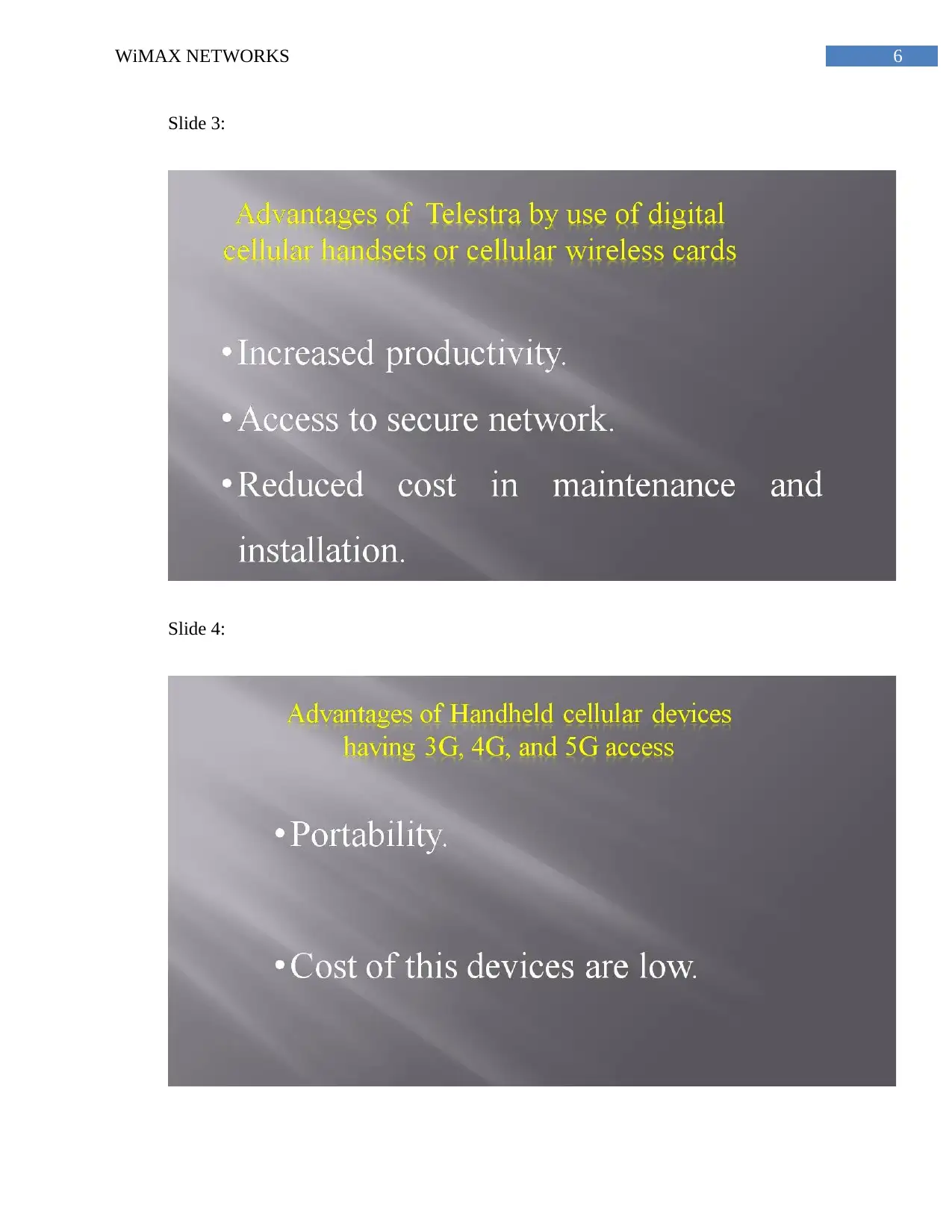
6WiMAX NETWORKS
Slide 3:
Slide 4:
Slide 3:
Slide 4:
Paraphrase This Document
Need a fresh take? Get an instant paraphrase of this document with our AI Paraphraser
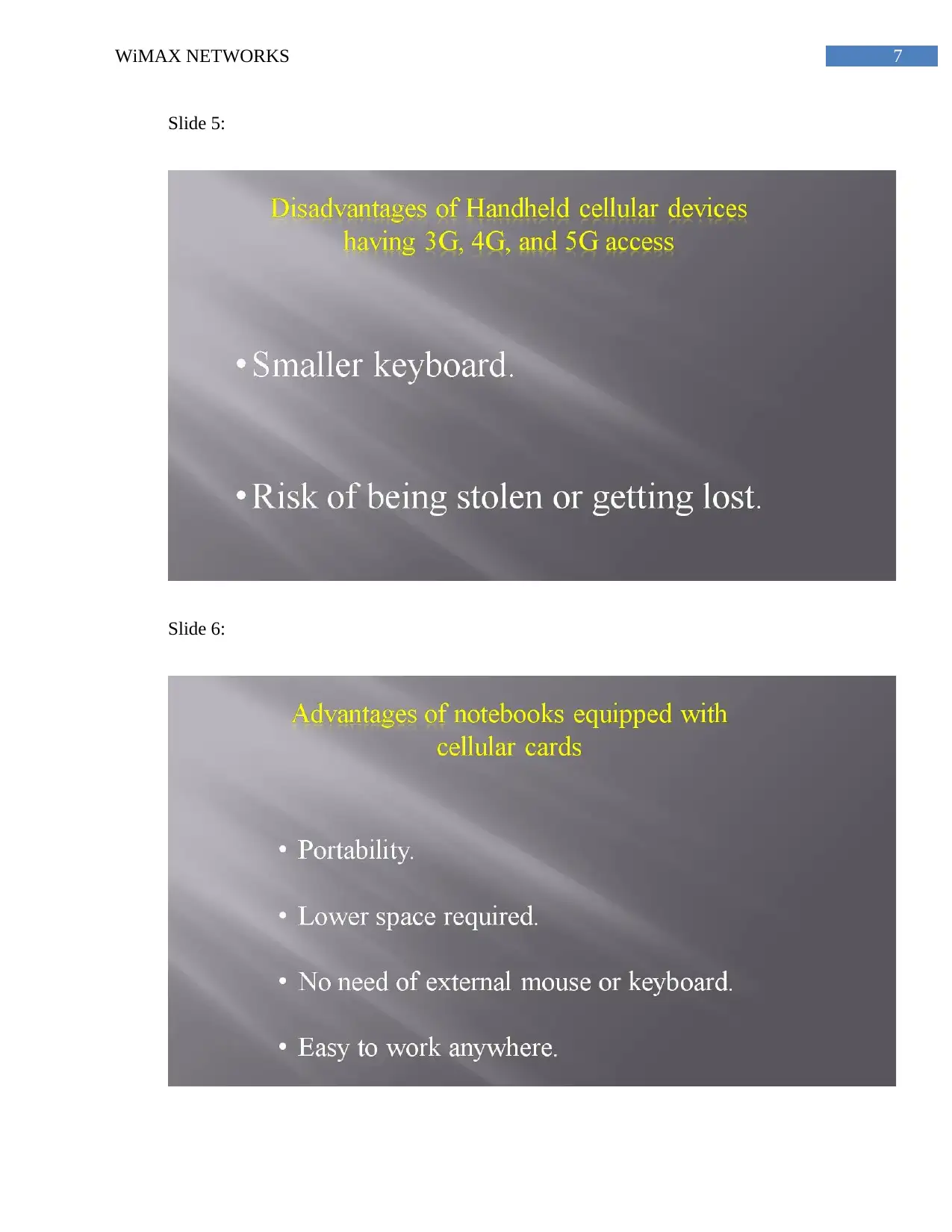
7WiMAX NETWORKS
Slide 5:
Slide 6:
Slide 5:
Slide 6:
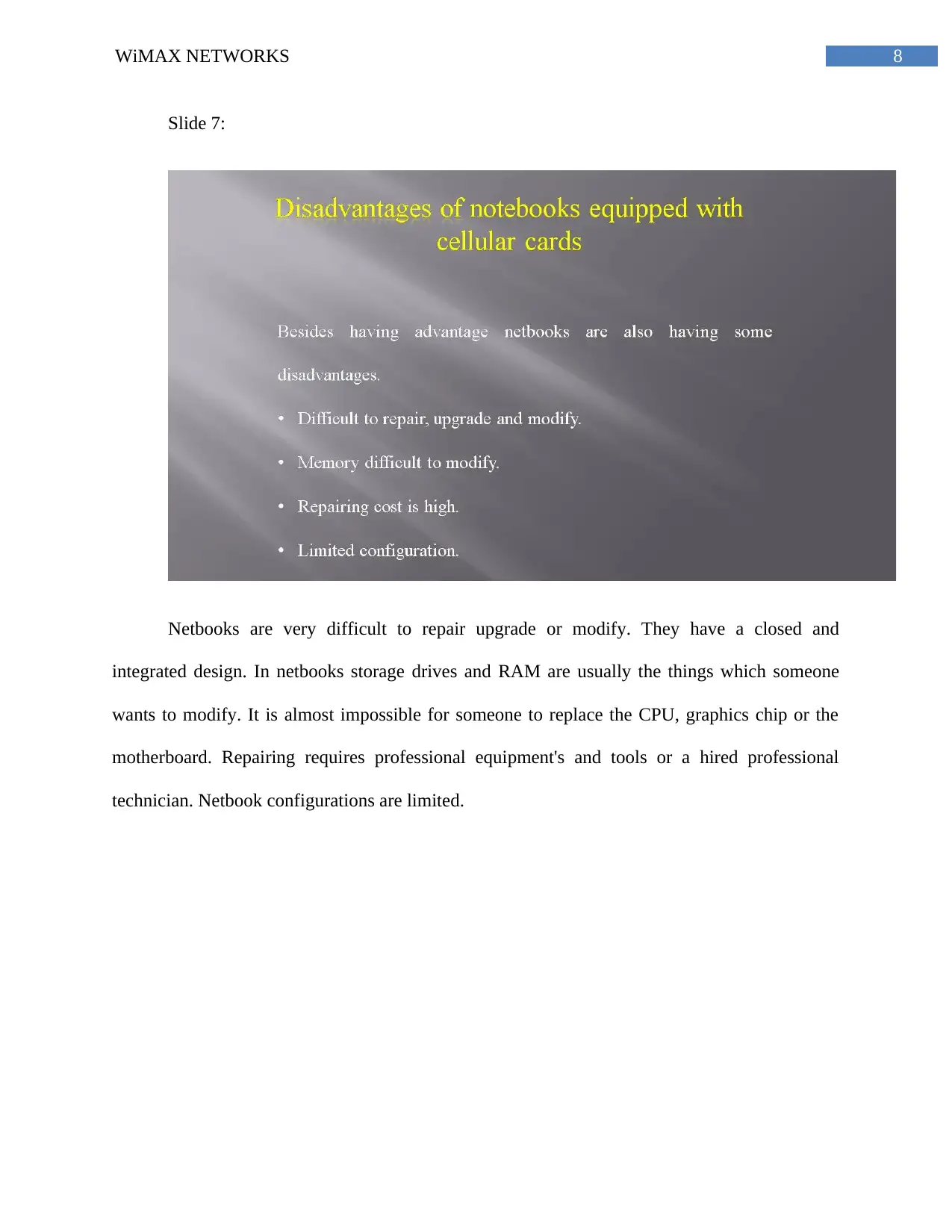
8WiMAX NETWORKS
Slide 7:
Netbooks are very difficult to repair upgrade or modify. They have a closed and
integrated design. In netbooks storage drives and RAM are usually the things which someone
wants to modify. It is almost impossible for someone to replace the CPU, graphics chip or the
motherboard. Repairing requires professional equipment's and tools or a hired professional
technician. Netbook configurations are limited.
Slide 7:
Netbooks are very difficult to repair upgrade or modify. They have a closed and
integrated design. In netbooks storage drives and RAM are usually the things which someone
wants to modify. It is almost impossible for someone to replace the CPU, graphics chip or the
motherboard. Repairing requires professional equipment's and tools or a hired professional
technician. Netbook configurations are limited.
⊘ This is a preview!⊘
Do you want full access?
Subscribe today to unlock all pages.

Trusted by 1+ million students worldwide
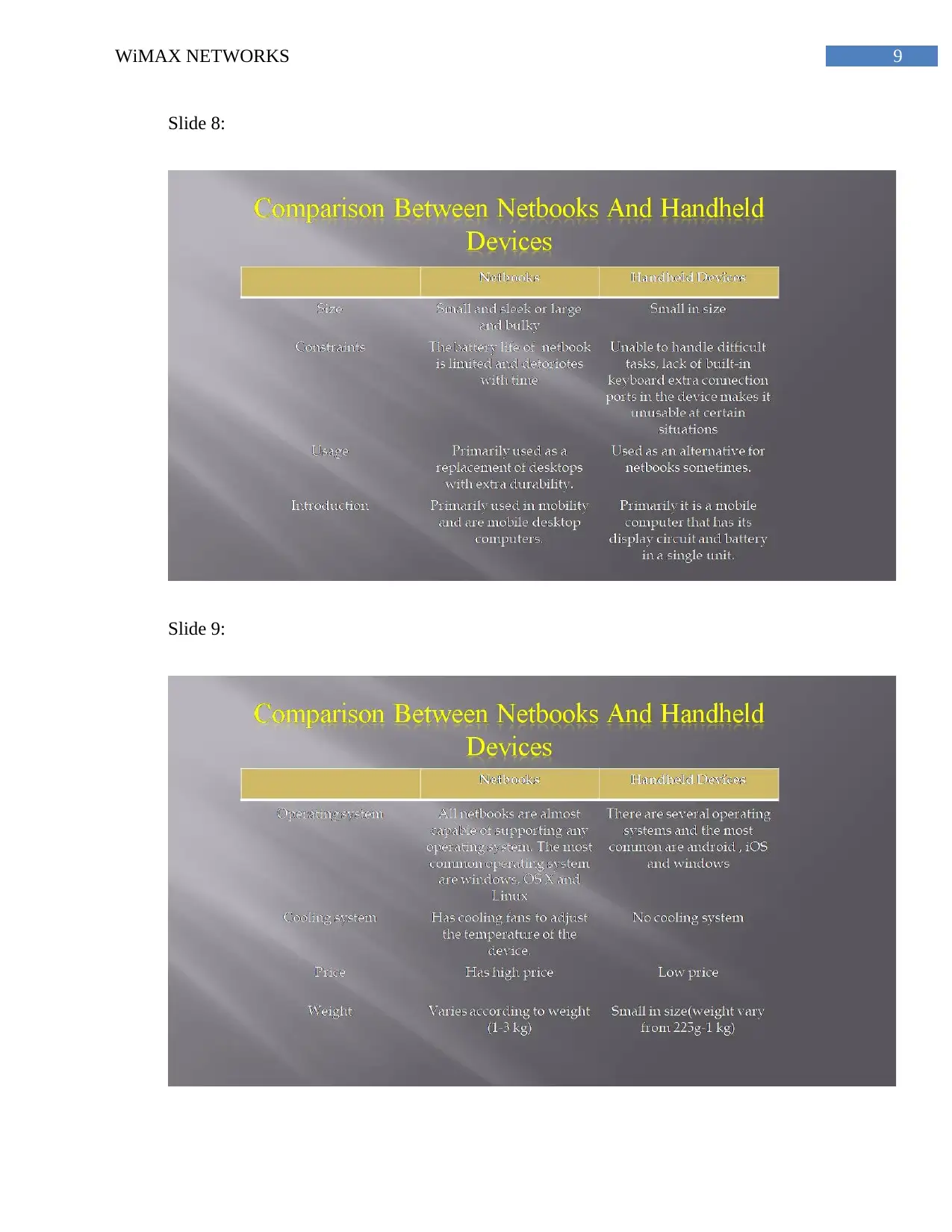
9WiMAX NETWORKS
Slide 8:
Slide 9:
Slide 8:
Slide 9:
Paraphrase This Document
Need a fresh take? Get an instant paraphrase of this document with our AI Paraphraser
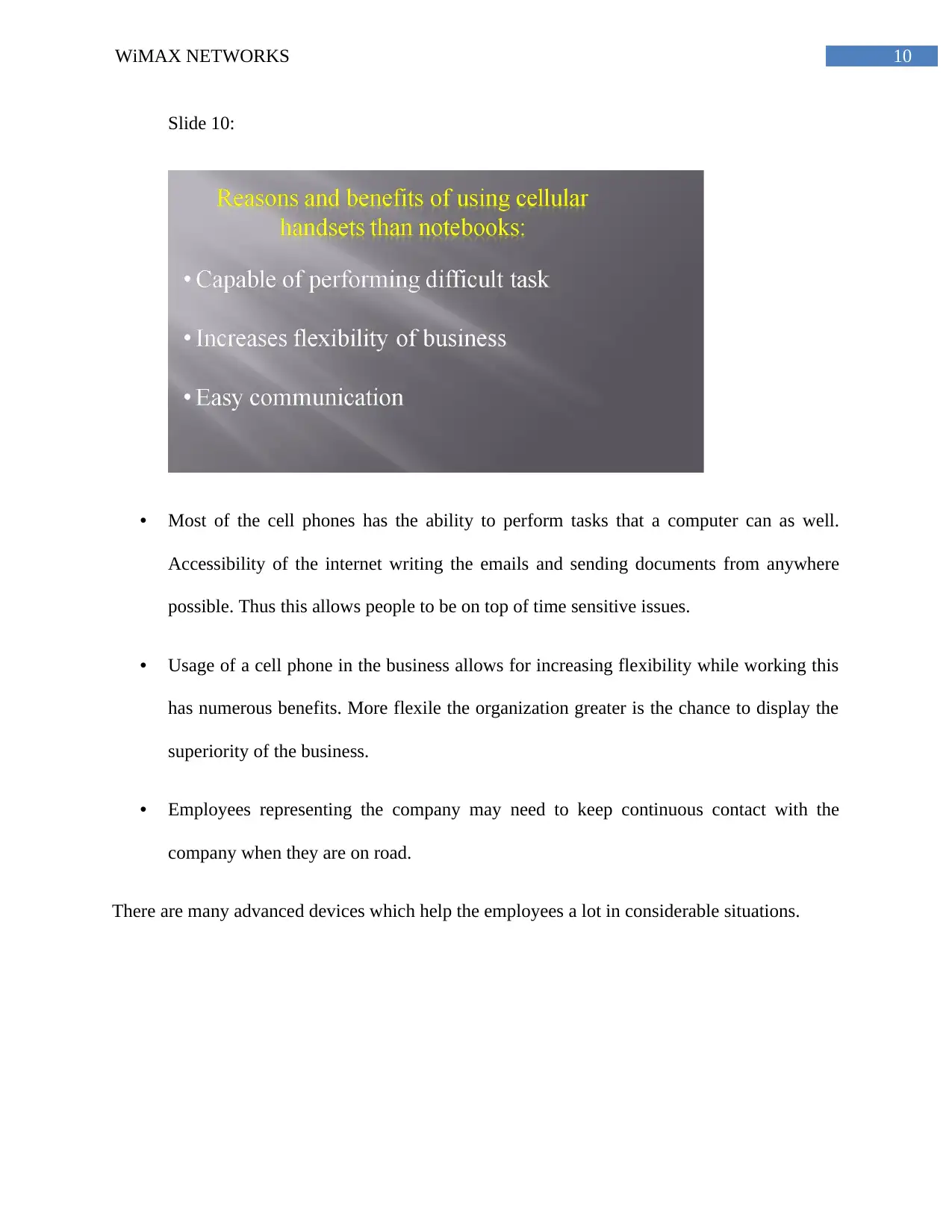
10WiMAX NETWORKS
Slide 10:
• Most of the cell phones has the ability to perform tasks that a computer can as well.
Accessibility of the internet writing the emails and sending documents from anywhere
possible. Thus this allows people to be on top of time sensitive issues.
• Usage of a cell phone in the business allows for increasing flexibility while working this
has numerous benefits. More flexile the organization greater is the chance to display the
superiority of the business.
• Employees representing the company may need to keep continuous contact with the
company when they are on road.
There are many advanced devices which help the employees a lot in considerable situations.
Slide 10:
• Most of the cell phones has the ability to perform tasks that a computer can as well.
Accessibility of the internet writing the emails and sending documents from anywhere
possible. Thus this allows people to be on top of time sensitive issues.
• Usage of a cell phone in the business allows for increasing flexibility while working this
has numerous benefits. More flexile the organization greater is the chance to display the
superiority of the business.
• Employees representing the company may need to keep continuous contact with the
company when they are on road.
There are many advanced devices which help the employees a lot in considerable situations.

11WiMAX NETWORKS
Slide 11:
Slide 11:
⊘ This is a preview!⊘
Do you want full access?
Subscribe today to unlock all pages.

Trusted by 1+ million students worldwide
1 out of 14
Related Documents
Your All-in-One AI-Powered Toolkit for Academic Success.
+13062052269
info@desklib.com
Available 24*7 on WhatsApp / Email
![[object Object]](/_next/static/media/star-bottom.7253800d.svg)
Unlock your academic potential
Copyright © 2020–2025 A2Z Services. All Rights Reserved. Developed and managed by ZUCOL.





